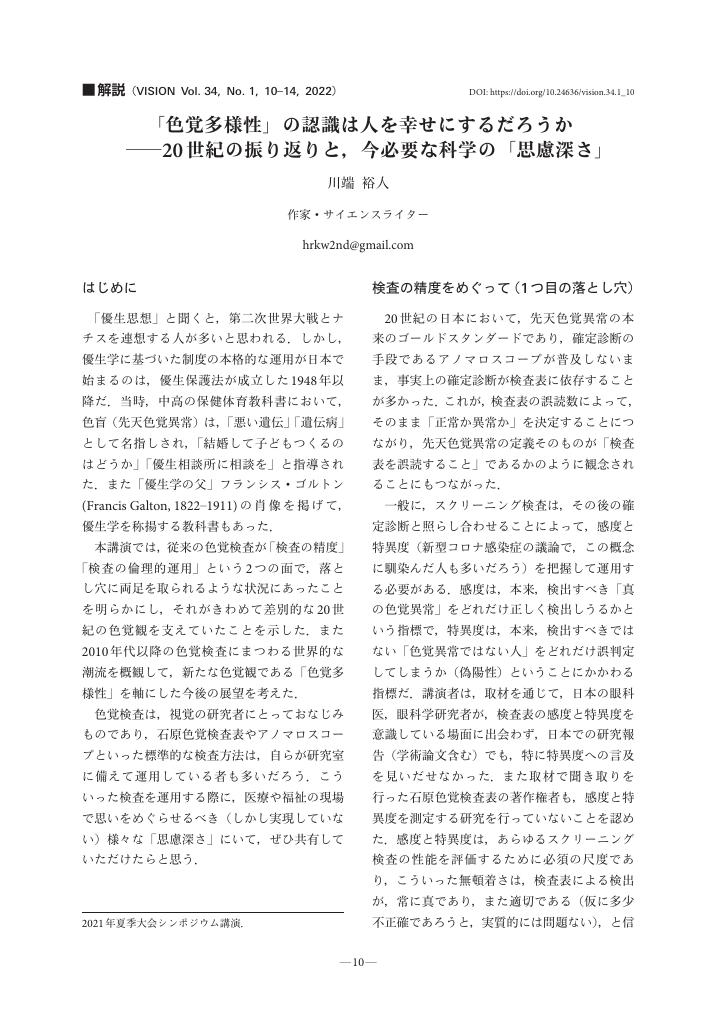212 0 0 0 OA 優生思想の標的としての「色覚異常」から「色覚多様性」の時代へ
- 著者
- 川端 裕人
- 出版者
- 日本健康学会
- 雑誌
- 日本健康学会誌 (ISSN:24326712)
- 巻号頁・発行日
- vol.88, no.5, pp.165-182, 2022-09-30 (Released:2022-10-26)
- 参考文献数
- 38
In the 20th century, people with congenital color vision deficiency (CVD) were subjected to eugenic ideology and suffered genetic discrimination in Japan. This paper first suggests the involvement of science (so-called eugenics) and medicine (ophthalmology) in the background.The Japanese Society of Race Hygiene, founded in 1930, was keen to introduce eugenics into Japan and they used CVD as a prime example when promoting their idea. One reason was that CVD could be easily detected by the Ishihara plates developed by a Japanese ophthalmologist, and screening tests for all children were already being conducted nationwide. The Society have parted ways with eugenics since 1958. Epidemiology and public health thinking played a major role in their change of policy.Japanese genetic scientists in the 21st century, reflecting on the past, argued that it is more appropriate to understand CVD as a “normal” genetic polymorphism rather than an “abnormality”. Based on this idea, they proposed the concept of “color vision diversity”.However, even now, Japanese society has not dispelled the notion that CVD is genetically inferior. One reason is that ophthalmologists, who are considered authorities on color vision, cling to the idea that CVD is abnormal. Redesign of testing and diagnosis is also important, as studies have accumulated showing that testing with the Ishihara plates is not accurate. Evidence-based epidemiology and public health approaches may be useful here as well.
55 0 0 0 OA 「色覚多様性」の認識は人を幸せにするだろうか――20世紀の振り返りと,今必要な科学の「思慮深さ」
- 著者
- 川端 裕人
- 出版者
- 日本視覚学会
- 雑誌
- VISION (ISSN:09171142)
- 巻号頁・発行日
- vol.34, no.1, pp.10-14, 2022-01-20 (Released:2022-02-01)
- 参考文献数
- 7
8 0 0 0 日常がSFになってしまった時に「科学作家」がすること
- 著者
- 川端 裕人
- 出版者
- アジア日本言語文化研究会
- 雑誌
- 日本言語文化研究 (ISSN:24346780)
- 巻号頁・発行日
- vol.4, 2021
- 著者
- 川端 裕人
- 出版者
- 日本視覚学会
- 雑誌
- VISION (ISSN:09171142)
- 巻号頁・発行日
- vol.34, no.1, pp.10-14, 2022
- 著者
- 川端 裕人
- 出版者
- 中央公論新社
- 雑誌
- 中央公論 (ISSN:05296838)
- 巻号頁・発行日
- vol.134, no.7, pp.92-99, 2020-07
3 0 0 0 17世紀、出島に「来日」していたドードーをめぐって
- 著者
- 川端 裕人
- 出版者
- ヒトと動物の関係学会
- 雑誌
- 動物観研究 : ヒトと動物の関係学会誌 (ISSN:09168354)
- 巻号頁・発行日
- no.21, pp.35-37, 2016-12
1 0 0 0 OA 日常がSFになってしまった時に「科学作家」がすること
- 著者
- 川端 裕人
- 出版者
- アジア日本言語文化研究会
- 雑誌
- 日本言語文化研究 (ISSN:24346780)
- 巻号頁・発行日
- vol.4, pp.13, 2021 (Released:2021-08-18)

